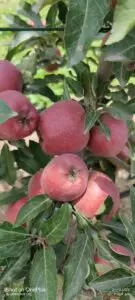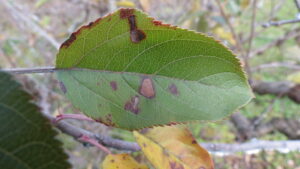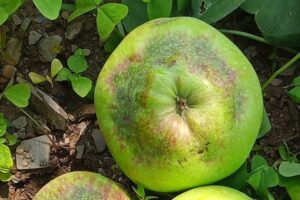Apples are a delicious and versatile fruit that can be enjoyed in many different ways. From pies and cobblers to salads and snacks, apples are a popular choice for people of all ages. But what many people don’t know is that apples go through a number of different stages of development before they are ready to be picked.
Here is a table that summarizes the different stages of apple fruit development:
| Stage | Description | Duration |
|---|---|---|
| Bud initiation | Flower buds are formed | Fall |
| Bud break | Flower buds open and flowers bloom | Spring |
| Cell division | Cells in the apple fruit divide rapidly | 4 weeks |
| Cell expansion | Cells in the apple fruit grow larger | 6 weeks |
| Ripening | Apple fruit changes color and flavor | 2-3 weeks |
Bud initiation
The first stage of apple development is bud initiation.
This occurs in the fall when the apple tree is dormant. During this stage, the flower buds for the following year are formed.
The first step in bud initiation is the formation of a primordium, which is a small, undeveloped bud. The primordium then grows and develops into a flower bud over the winter.
There are a number of factors that can affect bud initiation, including:
- Genetics: The type of apple tree and its genetic makeup can influence the number and size of flower buds that are formed.
- Nutrients: Apple trees need a number of nutrients in order to form flower buds, including nitrogen, phosphorus, potassium, and calcium. If the trees do not get enough nutrients, bud initiation may be delayed or reduced.
- Water: Apple trees need a regular supply of water in order to form flower buds. If the trees do not get enough water, bud initiation may be delayed or reduced.
- Temperature: Apple trees need a certain amount of cold weather in order to form flower buds. If the temperature is too warm, bud initiation may be delayed or reduced.
Once flower buds have been formed, they will remain dormant until the following spring. In the spring, the buds will open and flowers will bloom. If the flowers are pollinated, they will eventually develop into apples.
Bud initiation is an important process in the apple tree’s life cycle. It is the first step in the production of fruit, and it is influenced by a number of factors. By understanding the factors that affect bud initiation, growers can help to ensure that their apple trees produce a good crop of fruit.
Here are some additional details about bud initiation in apples:
- The timing of bud initiation varies depending on the apple variety. Some varieties initiate buds early in the fall, while others initiate buds later.
- The number of flower buds that are formed on an apple tree depends on a number of factors, including the tree’s age, health, and vigor. Younger trees tend to form more flower buds than older trees.
- Flower buds can be damaged by cold weather. If the temperature falls below a certain level, the buds may be killed.
- Flower buds can also be damaged by pests and diseases. Some common pests and diseases that affect apple trees include apple scab, powdery mildew, and fire blight.
By understanding the factors that affect bud initiation, growers can help to ensure that their apple trees produce a good crop of fruit.
Bud break
The next stage is bud break, which occurs in the spring. This is when the flower buds start to open and the flowers begin to bloom.
The timing of bud break varies depending on the apple variety. Some varieties break bud early in the spring, while others break bud later. The number of flowers that bloom on an apple tree depends on a number of factors, including the tree’s age, health, and vigor. Younger trees tend to bloom more than older trees.
Flowers can be damaged by cold weather. If the temperature falls below a certain level, the flowers may be killed. Flowers can also be damaged by pests and diseases. Some common pests and diseases that affect apple trees include apple scab, powdery mildew, and fire blight.
By understanding the factors that affect bud break, growers can help to ensure that their apple trees produce a good crop of fruit.
Here are some tips for promoting bud break in apple trees:
- Plant apple trees in a location that receives full sun.
- Water apple trees regularly, especially during the spring when the trees are breaking buds.
- Fertilize apple trees in the spring with a fertilizer that is high in nitrogen.
- Prune apple trees in the winter to remove dead, diseased, or crossing branches.
- Monitor apple trees for pests and diseases and treat them promptly if they occur.
By following these tips, you can help to ensure that your apple trees produce a good crop of fruit.
After the flowers bloom, the apple fruit begins to develop.
Cell division
The first stage of fruit development is cell division. During this stage, the cells in the apple fruit divide rapidly. This stage lasts for about 4 weeks.
Cell division is the process by which a cell divides into two identical cells. This process is essential for the growth and development of all living things, including apples.
In apples, cell division occurs in the flower buds. After the flowers are pollinated, the cells in the flower bud divide rapidly to form the fruit. The first stage of cell division is called mitosis. During mitosis, the cell’s nucleus divides into two identical nuclei. The cytoplasm then divides, forming two identical cells.
The second stage of cell division is called cytokinesis. During cytokinesis, the cell membrane divides, forming two separate cells.
Cell division is a continuous process in apples. It occurs throughout the life of the fruit, from the time it is first formed until it is ripe and ready to be picked.
The rate of cell division in apples is influenced by a number of factors, including the variety of apples, the amount of sunlight, the amount of water, and the temperature. In general, cell division occurs more rapidly in younger apples than in older apples. Cell division is also stimulated by sunlight and water.
Cell division is an essential process for the growth and development of apples. It is responsible for the formation of the fruit and its eventual ripening.
Cell expansion
The next stage is cell expansion. During this stage, the cells in the apple fruit grow larger. This stage lasts for about 6 weeks.
Cell expansion is the process by which cells increase in size. This process is essential for the growth and development of all living things, including apples.
In apples, cell expansion occurs after the cells have divided. The cells take in water and nutrients from the tree’s roots and leaves. As the cells take in water, they swell and increase in size.
Cell expansion is a continuous process in apples. It occurs throughout the life of the fruit, from the time it is first formed until it is ripe and ready to be picked.
The rate of cell expansion in apples is influenced by a number of factors, including the variety of apples, the amount of sunlight, the amount of water, and the temperature. In general, cell expansion occurs more rapidly in younger apples than in older apples. Cell expansion is also stimulated by sunlight and water.
Cell expansion is an essential process for the growth and development of apples. It is responsible for the formation of the fruit and its eventual ripening.
Ripening
The final stage of apple fruit development is ripening. During this stage, the apple fruit changes color and flavor. Ripening takes about 2-3 weeks.
Ripening is the process by which apples change from green to yellow or red, and from hard to soft. It is a complex process that is influenced by a number of factors, including the variety of apples, the temperature, and the presence of ethylene.
The ripening process begins when the apple is picked from the tree. The apple then produces a gas called ethylene, which triggers the ripening process. Ethylene is a natural plant hormone that is responsible for the ripening of many fruits, including apples, bananas, and tomatoes.
As the apple ripens, the starch in the fruit is converted to sugar. The apple also loses water, which makes it softer. The color of the apple also changes, depending on the variety. Some varieties, such as ‘Red Delicious’, turn red as they ripen, while others, such as ‘Golden Delicious’, turn yellow.
The ripening process can take anywhere from a few days to a few weeks, depending on the variety of apples. Once the apple is ripe, it can be eaten fresh or used in pies, cakes, and other desserts.
Here are some tips for storing apples so that they ripen properly:
- Store apples in a cool, dark place.
- Do not store apples in the refrigerator, as this can slow down or stop the ripening process.
- Do not store apples near other fruits that produce ethylene, such as bananas and tomatoes.
By following these tips, you can help to ensure that your apples ripen properly and taste delicious.
Once the apple fruit is ripe, it can be picked and enjoyed.
Factors Affecting Apple Fruit Development
A number of factors can affect apple fruit development. These factors include:
- Temperature: Apple trees need a certain amount of cold weather in order to flower and set fruit. If the temperature is too warm, the apple trees will not flower or set fruit.
- Water: Apple trees need a regular supply of water in order to grow and develop fruit. If the apple trees do not get enough water, the fruit will be small and misshapen.
- Nutrients: Apple trees need a number of nutrients in order to grow and develop fruit. These nutrients include nitrogen, phosphorus, potassium, and calcium. If the apple trees do not get enough nutrients, the fruit will be small and misshapen.
- Pests and diseases: Pests and diseases can damage apple trees and fruit. Some common pests and diseases that affect apple trees include apple scab, powdery mildew, and fire blight.

Growing Apples
If you are interested in growing your own apples, there are a few things you need to do. First, you need to choose a variety of apple trees that are suited to your climate. Once you have chosen a variety, you need to plant the trees in a sunny spot with well-drained soil. You also need to water the trees regularly and fertilize them once a year. With proper care, your apple trees will produce delicious fruit for many years to come.



